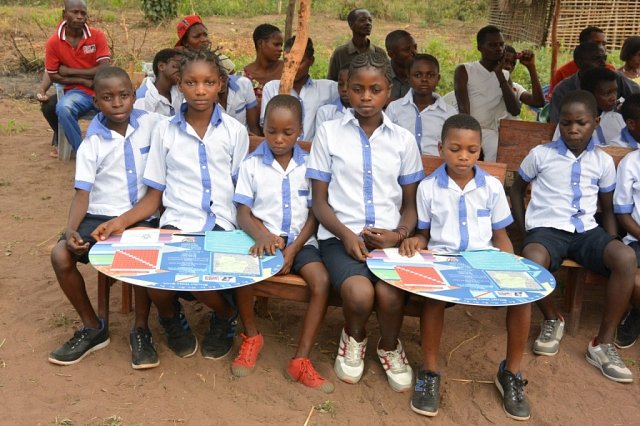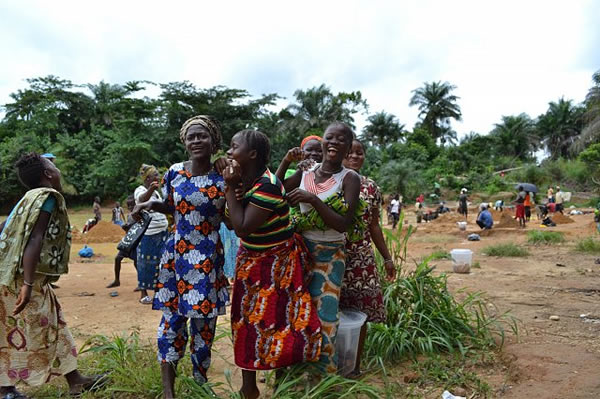The Diamond Development Initiative (DDI), the organization dealing with the traditional diamond mining, recently announced the appointment of Élodie Daguzan as its first Goodwill Ambassador.
Ms. Daguzan, who currently works as head of communication and industry relations for diamantaire Rubel & Ménasché, brings with her 17 years of experience in the diamond and jewelry industry. In an interview with Rough&Polished, Daguzan spoke about the challenges she faces and the programs implemented by DDI.
What priorities did you set for yourself as the DDI Goodwill Ambassador?
Our first priority within Rubel & Ménasché is to better understand Artisanal and Small-Scale Mining (ASM) and the challenges faced by the sector. I come from a very different universe, I have 17 years of experience in the diamond sector, most of it spent with Rubel & Ménasché, where I have developed my diamond knowledge from a technical, industry and high end jewellery perspective. When you are located in the heart of Paris as we are, ASM is not your primary field of expertise!
Nevertheless, it has always been of great interest to me. And with the help of DDI’s team and board members, I have an extraordinary opportunity to learn directly from the experts.
Our second priority is to raise awareness on ASM in the jewelry industry and especially within the high-end sector. The daily struggles of ASM are almost impossible to fathom at the other end of the pipeline for brands such as these. We wish to bridge this gap by sharing information, knowledge, ultimately de-stigmatising the sector.
[two_third]The third one, it is a big dream indeed, is to participate in a change in mindset that will allow the whole precious industry to understand that it is in our best interest to take care of our own. I sincerely believe that addressing the development possibilities of ASM can have a positive impact on the entire category, therefore providing a more sustainable environment for all businesses across the value chain.[/two_third][one_third_last]
“I sincerely believe that addressing the development possibilities of ASM can have a positive impact on the entire category, therefore providing a more sustainable environment for all businesses across the value chain.”
[/one_third_last]
What is your biggest concern?
One of our main concern is not being able to respectfully give this mission the appropriate amount of time it deserves.
 The other is the lack of understanding and awareness around ASM, there is a lot of work to do to change mindsets. The sector needs our attention as it is our collective responsibility, to engage and help support its formalisation one step at a time.
The other is the lack of understanding and awareness around ASM, there is a lot of work to do to change mindsets. The sector needs our attention as it is our collective responsibility, to engage and help support its formalisation one step at a time.
But I am an optimist and I have a blind faith in our industry, so concerns will fade and will make room for action. I am humbled by DDI ‘s support and blessed to be representing Rubel & Ménasché and thankful for the leadership who have empowered me to pursue my passion.
What is required to improve regulation of traditional diamond mining and create a free and open market for artisanal miners?
Those responsible for regulation—primarily producing countries and the Kimberley Process—need to feel a need to improve it. I think the push will come ultimately from society. We are seeing it now – with diamonds, with gold, and with minerals used to produce smart phones and other technological devices.
But more specifically there are two things that are critical. The first is education at mine site level and the second is on the policy front, meaning encouraging governments to formally recognize artisanal mining in order to allow the legal framework needed to operate in a responsible manner. Essentially, what is required is a joint effort from industry and government.
Industry is willing to provide capacity building programmes and is already been doing it. As per example, DDI and AWDC led a joint training of rough valuation in June 2017 in Antwerp for KP representatives from 4 Participant countries. Or more recently, the GemFair pilot project that De Beers launched in partnership DDI.
But industry initiatives cannot succeed on their own. They need to be able to rely on a dedicated legal framework designed by committed governments that clearly see the value of ASM as a source of development.
Does DDI conduct a campaign to encourage demand for diamonds mined by the traditional method?
Actually, this is not DDI’s role. DDI implements on-sight programmes that strive to help support the formalization of artisanal mining and develop the communities relying on the mining sites for their livelihood. That is the core mandate of DDI and it is where its expertise and experience lie.
How to ensure the diamonds from artisanal miners are sold at fair prices?
Again, I would say that part of it has to do with education. DDI provides training on diamond valuation helping miners get a better understanding of the diamonds they are producing, therefore obtaining a more accurate value when selling those diamonds. This is of paramount importance as education ultimately leads to empowerment. Fair trade will come through diamond technical expertise.
The other part has to do with removing the stigma that is perceived of artisanal mining, as it can be run ethically, creating a huge beneficial impact on local communities. The industry as a whole is now fully aware of the urgency to address the formalization of ASM and the various initiatives undertaken by some of the leading players will also be a force for change in mindsets.
Fair prices will be a consequence of the desirability of ASM diamonds due to the ultimate good they will be doing in supporting the development of the sector and the surrounding communities.
What is the market share of diamonds that are mined in the traditional way unofficially?
A lot of artisanal diamond mining is done in what is called the “informal” sector, which means that it escapes taxation and national economic data collection. DDI’s best estimate is between 15% and 20% of global production by volume. By value it is less, but the total still represents hundreds of millions of dollars to rural communities in developing countries. DDI is conducting a research that will soon provide more details on a country-by-country basis.
At what stage of implementation is the supply of “development diamonds” to the market?
DDI has developed a detailed set of standards—the Maendeleo Diamond Standards™— for artisanal mined diamonds. These standards were developed in close consultation with the RJC, some leaders in the industry, African governments and miners themselves. DDI has organized mining groups around these standards and is putting together third-party monitoring to ensure compliance. Several pilots have been run in getting these diamonds to market, some more successful than others. The main challenge DDI has faced is not the miners and their adherence to standards, it is the creation of a dependable route to market. DDI are working on pilots to address these challenges and are hopeful that GemFair will turn this into reality.
Which countries are covered by the DDI programs?
DDI’s primary activities are in Sierra Leone and the Democratic Republic of Congo, but they have additional activities in Guinea and Liberia, and are investigating possibilities in Côte d’Ivoire. They have conducted research on artisanal diamond mining in several other countries as far afield as Tanzania and Guyana.

Does DDI face a financing problem?
DDI is a non-profit, charitable organization, and there is never enough money to address the challenges faced in the artisanal sector. They have had very positive support from across the industry and from some government funders. The German government (GIZ) has been especially supportive. One of the major hurdles faced in general is to find donors who understand the importance of sustained, multi-year programmes. Artisanal diamond mining problems cannot be solved in small, one- and two-year efforts. Sustainability needs long term commitment.
As Goodwill Ambassador, this is an area I can only hope to have a positive impact on. Being with Rubel & Ménasché for 7 years now, we operate in the high-end jewellery sector. The one and only where savoir-faire is king, excellence is the minimum requirement and reputation is your priceless possession. That particular segment of the pipeline has a real stake in the desirability of the product category that is why I hope to foster dialogue through knowledge, understanding that would transform into mutual added value and hopefully commitment.
In your opinion, how effective is the Kimberley Process in terms of ensuring transparency in diamond trade?
The Kimberley Process shone a bright light on the international diamond trade and made it impossible for large-scale conflict diamond operations to continue. It brought much-needed transparency to the industry. But any regulatory system needs to keep up with the challenges that inevitably develop, and the KP has found this difficult. The KP is actually undergoing a three-year review cycle and has created a dedicated Ad Hoc Committee on Review and Reforms to tackle reform. One of the main focus is the strengthening of the Peer-Review Mechanism. It is a critical point as it will enable an adequate implementation the minimum requirements which in turn provide Participant countries with more accurate monitoring of diamonds cross-country movements.
DDI is actively participating in the review through the Ad Hoc Committed and hopes that the proposed reforms that they and other Participants and Observers have put forward will be accepted by the plenary and transformed into actionable/practical changes.

What the blockchain technology can give for the diamond industry?
The blockchain technology is being tested by a few industry players, including De Beers who are working on developing an industry wide solution. My Our understanding is that this Diamond Industry Blockchain will complement the existing measures such as the Kimberley Process by providing a tamper-proof, immutable record of a diamond’s journey throughout the value chain. This has the potential to be a game-changer for the industry in addressing some of the main areas of discussion throughout the supply chain.
It will underpin continued consumer confidence in diamonds by having one central ledger that contains an immutable record of a diamond’s journey throughout the value chain and guarantees its authenticity.
Millennials help to increase the demand for synthetic diamonds, succumbing to the image created by its producers, assuring that their diamonds are not associated with the exploitation of labor and do not harm the environment. Do you see here a problem?
It is unfortunate that synthetic advertisements use the plight of the artisanal mining sector to promote their own interests. By alienating ASM, synthetic producers undermine the livelihoods of over 1.5 million people working in the sector and this is a major issue. Marginalising the sector does not represent responsible business practices neither does it promote social development.
The answer is not to punish ASM, it is to bring it into the formal economy, making sure that diggers are fairly paid, working in safe and healthy environment and that their efforts are environmentally sound. That is what DDI is all about!
